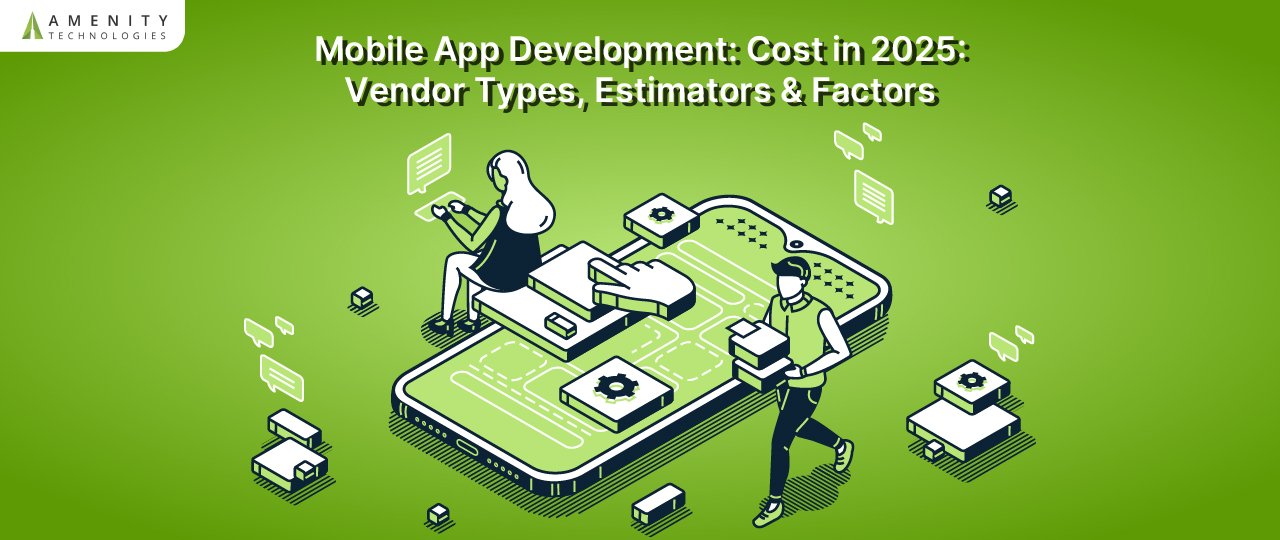Curious about mobile app development cost in 2025? How do some apps launch for $5,000 while others exceed $500,000? Recent data shows the average development cost at around $171,450, and the cost varies due to app complexity, platform choice, and features. Even small variations in design or functionality can significantly shift budgets, making planning a careful process.
Understanding what drives costs helps businesses allocate resources efficiently. From choosing between a simple MVP and a full-feature enterprise app to considering regional pricing, knowing where your investment goes ensures better financial planning and fewer surprises during development.
Why Mobile App Development Cost Varies So Widely in 2025?
The mobile app development cost in 2025 is influenced by several key factors that can significantly impact the final price. Understanding these factors is essential for businesses looking to budget effectively for their app development projects.
1. Complexity Spectrum
The complexity of an app plays a major role in determining its development cost. Simple apps with basic functionalities can cost as little as $5,000, while highly complex applications with advanced features can exceed $500,000. Here’s how the price may differ based on complexity spectrum:
| App Type | Price | What’s Included |
| Simple | $40,000 – $60,000 | Core features for basic app functionality: user registration/login, basic navigation, simple content display, minimal notifications, single-platform support (iOS or Android), basic UI/UX design, standard testing. |
| Medium | $60,000 – $150,000 | Expanded functionality: cross-platform support, multiple integrations (APIs, payment gateways), push notifications, more advanced UI/UX, moderate backend complexity, analytics tracking, QA/testing, moderate security features. |
| Enterprise | $150,000 – $250,000 | Full-featured app with complex backend and database, custom security, multi-platform support, third-party integrations, advanced UI/UX, in-depth analytics, scalability, dedicated QA/testing, and post-launch maintenance/support. |
2. Platform Influence
Choosing between native and cross-platform development affects both cost and performance. Native apps, developed specifically for one platform, tend to be more expensive due to the need for separate codebases and specialized expertise. Cross-platform apps, on the other hand, allow for a single codebase to run on multiple platforms, potentially reducing development time and cost.
3. Feature Customization
The scope of features included in an app directly impacts its development cost. Minimum Viable Products (MVPs), which include only the essential features, are more cost-effective, with prices ranging from $20,000 to $50,000. In contrast, full-feature apps with comprehensive functionalities can cost significantly more, depending on the complexity and number of features.
4. Regional Pricing
Development costs vary by region due to differences in labor rates, economic conditions, and market demand. For example, development costs in North America and Western Europe are generally higher compared to regions like Eastern Europe or Asia, where labor costs are lower. This geographical disparity can influence the overall cost of app development projects.
Vendor Types & Their Cost Profiles
Selecting the right vendor significantly impacts mobile app development cost and project outcomes. Understanding what each type delivers helps businesses match their goals with the appropriate expertise.
1. Freelancers & Small Teams
Freelancers and small teams provide affordable options for small projects or MVPs. They offer flexibility and fast turnaround but may struggle with complex apps or large-scale projects. Limited resources can affect support, documentation, and long-term maintenance.
2. Mid-sized Development Studios
These studios handle medium-complexity apps efficiently. They offer structured project management, UI/UX design, backend development, QA, and post-launch support. Their experience ensures smoother delivery and moderate costs.
3. Enterprise-Level Vendors
Enterprise vendors specialize in complex applications requiring high security, scalability, and integrations. They provide full-service project execution, dedicated teams, and advanced QA, but at higher costs.
4. Offshore/Hybrid Teams
Hybrid models combine local project management with offshore development to reduce expenses. Cost savings are significant, but success depends on effective communication, process discipline, and time zone coordination.
Let’s understand the cost of mobile app development as per the vendor type:
| Vendor Type | Typical Hourly Rate (USD) | Description | Ideal Use Case |
| Freelancers & Small Teams | $20–$80 | Affordable options for small projects or MVPs. Flexible and fast but may lack resources for complex apps or long-term maintenance. | Startups, MVPs, small apps with simple functionality |
| Mid-sized Development Studios | $50–$120 | Handle medium-complexity apps with structured project management, UI/UX design, backend development, QA, and post-launch support. | Growing businesses, apps requiring moderate complexity and support |
| Enterprise-Level Vendors | $100–$250 | Specialize in complex, large-scale applications with high security, scalability, and integrations. Full-service execution with dedicated teams. | Large-scale apps, enterprise solutions, mission-critical applications |
| Offshore/Hybrid teams | $20–$100 | Combine local management with offshore development to reduce costs. Require strong communication and process discipline. | Businesses looking to optimize costs while maintaining oversight |
How to Estimate Your Mobile App Development Cost?
Estimating mobile app development cost accurately requires evaluating multiple factors that influence final pricing.
1. Use Feature-Based Estimators
Break down your app into core modules and features. Assign estimated development hours or cost for each feature, such as login/authentication, push notifications, payment gateways, or reporting dashboards. This granular approach provides a realistic picture of total costs.
2. Region-Specific Hourly Rates
Development rates vary by geography. For example, developers in North America may charge $100–$250/hour, whereas Eastern Europe rates range from $40–$100/hour, and Asia from $20–$60/hour. Selecting a region strategically can optimize costs without compromising quality.
3. Platform and Tech Stack Choices
Native apps for iOS and Android usually require separate codebases, increasing cost. Cross-platform frameworks like Flutter or React Native allow a single codebase for multiple platforms, reducing development time and expense. Tech stack selection also affects backend, database, and integration costs.
4. Hidden Costs and Post-Launch Expenses
Plan for ongoing maintenance, updates, server hosting, cloud storage, and third-party service fees. These can add 15–25% to the initial development cost. Considering these early ensures no budget surprises and smoother project execution.
Why Amenity Technologies Is the Right Mobile App Development Partner?
Choosing the right partner affects both quality and mobile app development cost. Amenity Technologies provides solutions that help businesses control budgets while ensuring efficient delivery.
1. Transparent Costing with Feature-Level Breakdown
We provide detailed estimators for every feature, helping businesses avoid unexpected costs. Clients receive a clear view of what each module costs, enabling smarter budgeting.
2. Vendor Model Flexibility
Businesses can select dedicated teams or hybrid support, giving full control over timelines, resources, and costs.
3. Experience Across Platforms
Our team delivers both native and cross-platform apps, optimized for speed, performance, and reliability.
4. Industry-Aligned Solutions
We have proven experience in healthcare, fintech, logistics, and other sectors. Our approach aligns development with industry-specific requirements while maintaining cost efficiency.
Conclusion
Mobile app development cost in 2025 varies based on platform, app complexity, vendor type, and regional factors. Understanding these drivers allows businesses to budget more accurately and avoid surprises.
From simple MVPs to enterprise-grade applications, assessing price ranges, vendor profiles, and hidden costs ensures informed decision-making.
Partnering with Amenity Technologies provides transparent costing, flexible vendor models, and expertise across platforms and industries, helping businesses control expenses while achieving high-quality outcomes in their mobile app development projects. Contact us today for AI-powered mobile app development.
FAQs
1. What’s the minimum cost to build a mobile app in 2025?
The minimum mobile app development cost starts around $5,000 for a simple MVP. This includes core functionality, basic UI/UX, and single-platform deployment. Prices increase with additional features, integrations, and platform support.
2. How much can cross-platform development reduce costs?
Cross-platform development can reduce mobile app development cost by 10–30% compared to building separate native apps for iOS and Android. It allows one codebase to serve multiple platforms, shortening development time and lowering labor costs.
Plan for post-launch maintenance, server hosting, app updates, third-party services, and licensing fees. Hidden costs can add 15–25% to the initial mobile app development cost, so accounting for them upfront ensures better budget management.
4. Which vendor model is best for startups?
Freelancers or mid-sized development studios are ideal for startups. They provide cost-effective solutions, flexibility, and moderate support without the high overhead of enterprise-level vendors, helping control mobile app development cost.
5. How do I estimate long-term maintenance budgets?
Allocate 15–20% of the initial mobile app development cost annually for maintenance, updates, bug fixes, and server upkeep. This ensures the app remains secure, functional, and compatible with OS updates.
6. How can I avoid scope creep and budget overruns?
Define project requirements clearly, document all features, and maintain regular communication with the development team. Using detailed feature-based estimators helps control mobile app development cost and prevents unexpected expenses during development.












